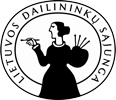Aš tyrinėju daiktų gyvenimą, bandydamas atsakyti į klausimus: kas daiktas yra? Koks jo santykis su žmogumi? Ar daiktas – tik idėja, o mes pažįstame tik jo funkciją? Kuo tampa daiktas jį atskyrus nuo tos funkcijos – palikus tik daikto vaizdą, o jį patį perkėlus į kitą kontekstą?
Mes gyvename daiktų pasaulyje, kur jie, būdami savotiški mūsų kūno tęsiniai (anot M. McLuhano) užpildo mūsų kasdienybę. Gyvendami šalia mūsų, daiktai, kaip žmogaus sukurti artefaktai, ilgainiui tampa nebepastebimi: tarsi įauga į mūsų buitį. Kai kurie jų atrodo reprezentatyvesni už kitus, kai kurie – nugyvena pasislėpę stalčiuose ar sandėliukuose. Tačiau net ir masinės gamybos produktai vis vien turi savo unikalumą, kuris pasireiškia per santykį su daikto naudotojo (žmogaus) paliekamomis žymėmis: jos įrašo juose savotišką „informacinį kodą“ apie daikto šeimininką. Kita vertus, kiekvienas daiktas pasižymi savo forma, į kurią „įvelkamas“ funkcionalumas – dizainu.
Išplėšęs daiktus iš buities, pabandžiau atlikti savotišką „chirurginę intervenciją“, uždarydamas daikto vaizdą stikliniuose konteineriuose, taip juos dematerializuodamas. Tačiau kartu, neleisdamas jiems galutinai pranykti idėjų pasaulyje, palikau realius daikto fragmentus kaip užuominas į jų buvimą čia ir dabar, sugrąžinus juos į mūsų realybę. Tai – savotiškas daiktų „preparavimas“ arba realaus funkcionalumo atributų „implantavimas“ siekiant išsiaiškinti, kuriame taške susiduria daiktas kaip funkcija ir daiktas kaip idėja.
Paroda suskirstyta į keletą zonų, kuriose tyrinėjami skirtingi objektai, turintys skirtingus funkcionalumo lygius.
Darbinis stalas, kurio egzistavimas susijęs su kitų daiktų buvimu ant jo – tai savotiškas kasdien naudojamo objekto etalonas. Kasdienis buvimas ir naudojimas siejasi su nuolatine kaita, kurią pabandžiau suspausti į plokštumą ir uždaryti daikto formoje.
Daiktai, užtikrinantys mūsų jaukumą (ventiliatorius, augalas, lygintuvas) – iliuzinį užtikrintumą gyvenimo stabilumu. Prie jų priskyriau augalą, gyvos gamtos darinį, kuris, atsidūręs namu interjere, tampa daiktu.
Specializuoti daiktai labiausiai siejasi su pirmine daikto kaip kūno pratęsimo sąvoka. Antropologiniu požiūriu, tai – pirminiai išgyvenimą garantuojantys technologiniai daiktai, hominidus1 išskiriantys iš kitų gyvūnų.
1 Hominidai – (lot. homo, kilm. hominis - žmogus + gr. e'idos - pavidalas), žmoginiai primatai arba didžiosios žmogbedžionės.
I explore the life of objects, trying to answer the following questions: what is an object? What is its relationship to human beings? Is an object just an idea, and we only know its function? What does an object become when separated from its function, when all that is left of it is an image, and it is placed in a different context?
We live in a world of objects, where they, as a kind of extension of our body (according to Marshall McLuhan), fill our everyday life. Living alongside us, objects, as man-made artefacts, eventually become invisible: they seem to become ingrained in our daily life. Some of them seem more representative than others, while others live their life hidden in drawers or storerooms. However, even mass-produced items still have their own uniqueness, which manifests through their relationship with the marks left by the user of the object (the human being): these marks inscribe in them a kind of "information code" about the owner of the object. On the other hand, each object has its own form, into which functionality "encapsulates", i.e. design.
After I had torn the objects out of the household, I have tried to perform a kind of "surgical intervention" by enclosing the image of the object in glass containers, thus dematerialising them. At the same time, however, without allowing them to disappear definitively into the world of ideas, I have left the real fragments of the object as allusions to their presence here and now, bringing them back into our reality. This is a kind of "dissection" or "implantation" of real functional attributes in order to clarify the point at which the object as function and the object as idea collide.
The exhibition consists of several zones where I explore different objects with different levels of functionality.
The work desk, whose existence links to the presence of other objects on it, is a kind of benchmark for the everyday object. Its daily presence and use relate to constant change, which I have tried to compress into a plane and lock down into the form of the object.
The objects that ensure our cosiness (the fan, the plant, the iron) – the illusory certainty of the stability of life. Among these, I have included the plant, a living product of nature, which becomes an object once it is in the interior of the house.
Specialised objects most closely connect to the original notion of the object as an extension of the body. From an anthropological point of view, they are the primary technological objects that guarantee survival and distinguish hominids2 from other animals.
2 Hominid /ˈhɒmɪnɪd/ a primate of a family ( Hominidae ) which includes humans and their fossil ancestors and also (in recent schemes) at least some of the great apes.






